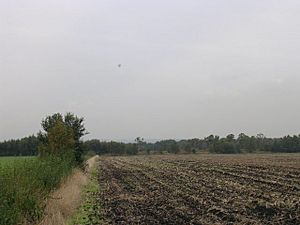Astley and Bedford Mosses facts for kids
| Site of Special Scientific Interest | |

Looking west across fields on Astley Moss
|
|
| Area of Search | Greater Manchester |
|---|---|
| Coordinates | 53°28′22″N 2°27′02″W / 53.4729°N 2.4506°W |
| Interest | Biological |
| Area | 228 acres (92 ha; 0.36 sq mi) |
| Notification | 1989 |
Astley and Bedford Mosses are special places in Greater Manchester, England. They are areas of peat bog, found south of the Bridgewater Canal and north of the Liverpool and Manchester Railway. You can find them about 2.5 miles (4 km) south-east of Leigh, in the areas of Astley and Bedford.
These mosses are important because they are some of the last parts of Chat Moss. Chat Moss was once a huge raised bog that covered about 10.7 square miles (27.7 km²) of south Lancashire. It was north of the River Mersey. Astley Moss became a Site of Special Scientific Interest (SSSI) in 1989. This means it's a protected area because of its special nature.
Astley and Bedford Mosses are also part of a bigger protected area called Manchester Mosses. This area includes Risley Moss and Holcroft Moss. It's a European Union designated Special Area of Conservation, which gives it even more protection.
Contents
What is a Bog?
A bog is a type of wetland that gets its water mostly from rain. Bogs are different from other wetlands because they are very acidic and low in nutrients. This makes them a unique home for special plants and animals.
How Did These Bogs Form?
The bogs at Astley and Bedford Mosses are called "lowland raised bogs." They started forming about 10,000 years ago, after the last ice age. Back then, there was a shallow glacial lake north of the River Mersey.
First, fen peat began to form in this area. This happened as reeds and rushes grew and then slowly decayed. Over time, a special type of moss called Sphagnum moss started to grow there.
The Role of Sphagnum Moss
Sphagnum mosses are amazing plants. They can hold a lot of water, like a sponge. As they grew, they made the water in the bog more acidic. This change from fen to bog peat caused the land to rise up, forming a dome-shaped "raised bog."
The acidic conditions created by Sphagnum mosses mean that only very special plants can grow here. Many of these plants are found almost nowhere else.
Wildlife at the Mosses
Astley and Bedford Mosses are very important for different kinds of wildlife. The unique environment supports plants and animals that need these specific conditions to survive.
Birds of Prey
This area is a great place for certain bird species, especially birds of prey. You might be lucky enough to spot some of these magnificent hunters:
- The merlin, which is a small and fast falcon.
- The hen harrier, a graceful bird that flies low over the ground while hunting.
- The short-eared owl, an owl that often hunts during the day.
These birds rely on the open spaces and the small animals that live in the bog for their food. Protecting the mosses helps these birds thrive.

